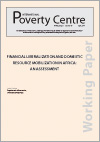
Financial Liberalization and Domestic Resource Mobilization in Africa: an Assessment
Resumo:Sub-Saharan Africa’s improving growth record in the first decade of the twenty-first century gives some hope that the potential for achieving the Millennium Development Goals will be enhanced by the improved economic conditions of the disadvantaged citizens of these countries. However, growth alone, even if it were much higher, would not be sufficient to ensure the achievement of the MDGs. The resources required for achieving them are beyond the capacity of most of these countries at present, and in the immediate future. Thus, for the region, the MDGs will be achievable only with substantial external resource inflows. In the immediate term, these resource inflows might also help to relieve the savings and foreign exchange constraints faced by most of these countries. However, movement to a higher growth and human development trajectory and eventual progress beyond such heavy dependence on external assistance require that these countries continue to develop their capacity for domestic resource mobilization. This is an area where progress is decidedly wanting for much of the region. Since 1980, Africa has had the weakest domestic resource mobilization record of any region (see Table 1 of the Appendix). On average, foreign savings have been necessary for funding more than 35 per cent of the region’s already low investment levels (see Table 2 of the Appendix). And, more to the point, these foreign resource inflows have come largely in the form of official development assistance rather than private capital flows. Given this record, if the region does not significantly improve domestic resource mobilization over the next decade, increased resource inflows pose a serious risk of entrenching (or institutionalizing) aid dependency—a situation in which high levels of external assistance perpetuate or exacerbate low savings rates. In this situation, countries lose the capacity to mobilize the resources necessary for generating even moderate growth in the absence of such aid. (...)